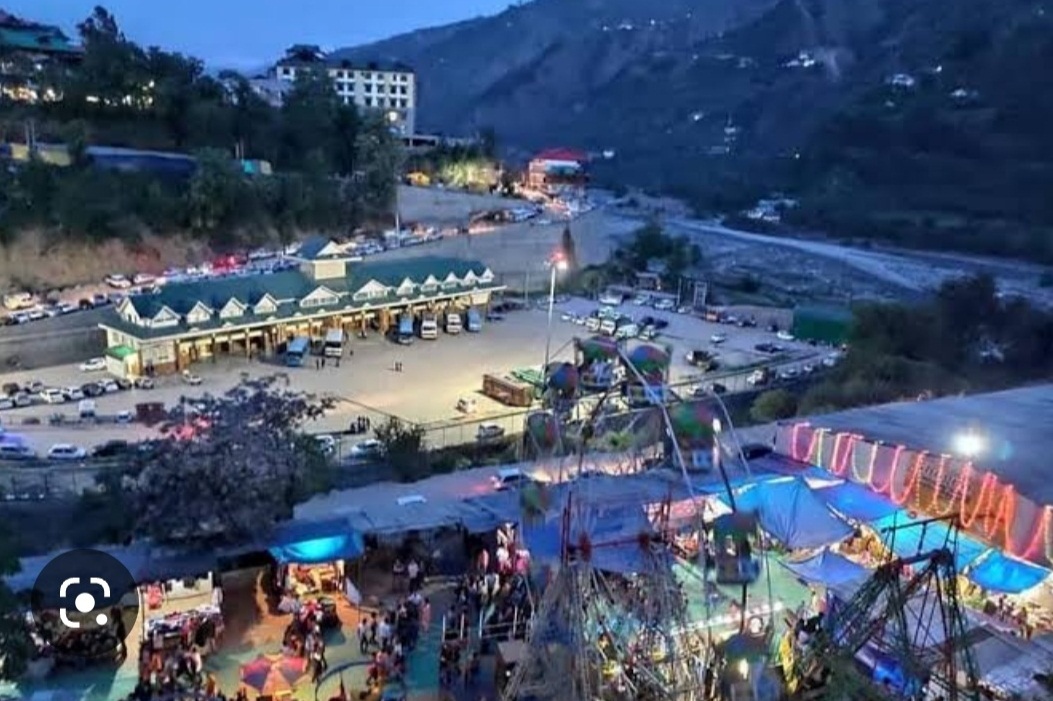A Confluence Of Fairs & Tourist Spots : Rampur Bushehr

“Travelling leaves you speechless, then turns you into a story teller” —Ibn Batuta
Post by Colonel Satish Singh Lalotra
Travelling is important for humans. We are communal creatures that are all of the same species yet our location determines societal actions based on cultural and government laws. Travelling is important for human happiness and mental health. Studies show that travelling can be a great mental and physical stimulus in today’s highly demanding world where individuals are constantly slammed with the stress of work, relationships and maintaining a family.
It can be incredibly intimidating to travel to places beset with languages and cultural barriers, learning emotional regulations and the like. Army is one such wonderful organization which builds ‘hands on experience’ in its personnel to overcome the hiccups posed by the vicissitudes of terrain, people, languages, and cultural diversity strengthening mental and physical resilience in the bargain by its very nature of posting them all over the country and even abroad.
This enabling of an individual to take on all the above imponderables in his stride while travelling becomes imprinted in his psyche for life time and shapes eventually his personality. In one of my previous articles I had dwelled upon the royal estate of ‘Rampur Bushehr’ in general, but the present write up focuses in particular about the fairs (melas) and tourist spots which are like jewels in the necklace of one of the largest erstwhile estates of present day Himachal Pradesh as recollected by me.
Having had the opportunity of serving in general area of ‘Kinnaur’ in the mid-90s, I had the chance and occasion of crisscrossing many places of interest which included ‘Rampur Bushehr’ my present topic of interest. As mentioned in one of my previous articles on Rampur Bushehr, since it being one of the largest royal estates of HP which came into being in 1948 as a union territory the place still has an air of old world charm, intrigue, fairs, temples, and places of tourist interest yet to be notched up on a tourist’s map.
Fair and festivals are a part and parcel of our ancient civilization which are treasured to no end by us. They act as bridges of humanity for posterity. An important medium for the youth to help display their handicrafts, arts/artifacts as also cultural events that go with such events.
Himachal Pradesh has been bequeathed with an unparalleled amount of fairs and festivals with around the year itinerary for an avid traveller to explore, that act as a catalyst for its locals to display their talent. Changing times and socio-cultural milieu has off course affected the sheen of such events, but then kudos to the locals who have been the ‘standard bearers’ often maintaining the essence of such fairs and festivals by their sheer involvement in an unflinching manner.
Rampur Bushehr has primarily three (3) main fairs of consequence with which it can identify its very being i.e. ‘Faag Mela (fair), Lavi Mela and Dusshera mela of Saharan. ‘Faag Mela’ was the main fair which was the exclusive domain of royal house of Bushehr for its conductance and eventual survival through the time and tide of events. When the estate was amalgamated into HP, the city council of Rampur took upon itself to maintain the same tempo of celebrations year on year.
The day subsequent to ‘Holi’ festival is generally known as ‘Faag’ and in ancient times the revelry was a joint show of bonhomie and camaraderie between the ruler and the ruled. During these festivities the “local deities’ in human forms, a peculiarity of Rampur Bushehr were invited with their dance troupes who danced with gay abandon for three days.
On the second day of Faagmela these local deities took to the streets, lanes and by lanes of the town with their musical instruments in tow. The same norms of celebrations are being maintained even today. Bushehr is famous for still maintaining the age old ritual of local deities who all congregate finally at the ‘Padammahal’ where the royal house of Bushehr and the city council distribute largesse in the form of hard cash and goods in kind.
In olden days the ‘Rajmata’ (queen mother) of Rampur Bushehr used to invite all those prominent people who had association with the royalty to partake in the final celebrations at the Padammahal. While shifting focus on the second most important fair of Bushehr i.e. Lavimela, it will be of interest for a reader to know that this fair was initially a mark of ‘Friendship treaty”inked between the erstwhile state of Rampur Bushehr and Tibet which was sealed in the year 1681. But the Sino-Indian conflict of 1962 pushed this famous Lavimela to its margin of existence.
The readers will be surprised to know that even today this Lavimela is known as the largest business mela /fair north of Delhi with an eye on multitude of business transactions taking place in the mofussil areas of hilly terrain of entire Himachal Pradesh, Uttranchal combined. The word ‘Lavi’ has its origin from the local word ‘Loi’(woolen blanket ) which owing to passage of time and usage got distorted to present day ‘Lavi’.
Every year from 11th November till 14th November this festival /fair is celebrated with usual pomp and show. The mela was granted a state recognition in 1984 with an international tag in the year 1994 by the late CM of HP Mr Veer Bhadrsingh. It was during Maharaja Kehrisingh’s time (1639-1696) that a friendship treaty was signed between Rampur Bushehr and Tibet which too was an act of serendipity.
It is said Maharaja Kehrisingh went with a sizable size of his forces infiltrating via Shipki La pass deep into Tibet where he was confronted by the Tibetan General resulting into a brief skirmish. This skirmish later on paved the way for a treaty of armistice that eventually was converted into a friendship treaty. As per a Tibetan official record named as ‘Namgya’ consisting of 45 lines, this treaty of friendship eventually gave shape to a business environment between both states who further went ahead and established a permanent culture of trade ties resulting into the present day ‘Lavimela’.
Lavimela attracts business partners from far off places like Kullu, Shimla, Lahaul & spiti as well as the tribal areas of Kinnaur with their cultural troupes in all their splendour. The mela has been quite active in promotion and transaction of items like ‘Pashmina wool, woolen pattus, Gudum, Chilgoza, Khurmani, Almonds etc. Lord Dalhousie the then Governor general got a road built in 1850 to help transit these goods from across the border into the hinterland of India and vice versa.
The same road now goes by the name ‘Hindustan –Tibet road’ or NH- 05 with a dual purpose in mind by Lord Dalhousie i.e. to keep an eye on the frontier areas of India as part of the ‘Great game’ and also promote border area development in terms of business ties between the neighbouring states/countries. Rampur Bushehr has been quite famous for its mesmerizing tourist jaunts too which unfortunately fell into oblivion due to a general sense of apathy and lack of publicity to give a fillip to its USP.
Since Rampur Bushehr valley is full of Doedar, Kail, Texas Baccata trees, the flora of the area gets further rich due to a heavy snowfall that starts from October and lasts till May. Tourists over here can indulge in trekking, fishing, river rafting to their heart’s content. The region is famous for a wide array of temples and religious places which are sculptured along the famous ‘Nagar’/Pahari style of architecture.
These religious places have not only been a tourist attraction but also draw experts from the fields of architecture and engineering, art and sculpture from all the corners of the world for their research and doctoral studies. Padam mahal of Rampur Bushehr is an epitome of architectural marvel with a very high class of wood craft, stone craft and marvelous carving work. The entire palace has been made of wood and stones brought from Munish and Dhamredavillages. Mr Gurmel singh of Rampur was the chief architect of this Padam palace.
His son Mr Gurudev singh has been the life of this royal estate due to his multifarious activities and philanthropic pursuits. Mr Mansa Ram has been the ‘Man Friday’ in so far as colour scheme of this palace goes. The stone wall around Padam palace has been made from stones brought from village ‘Kanheri’ which used to be then chiseled into a definite shape by a group of about 4 to 5 labourers.
A special paste made from ‘Mash pulse’ used to be worked upon to create a mortar for the masonry. About 42 kms NE of Rampur Bushehr near ‘Saharan’ lies the exquisite temple of ‘Bhimakali’ which is related to the ancient capital of Shonitpur as found explained in our Hindu scriptures.
Saharan Bushehr is about 7500 feet above the mean sea level surrounded by lush green and verdant forests, lakes, and gurgling hill streams. This place is famous since ‘Dawparyug’ as found mentioned in our Hindu mythology. It has an excellent hotel maintained by the Himachal tourism by the name of ‘ShriKhand Hotel’ from where one can view an excellent high rising peak of ShrikhandKailash towering at about 18000 feet. From Saharan one can also go to the famous ‘Nalati stadium’ which was built in 1917.
Close by is located the breeding center of HP state bird –the Monal. A wonderful hot water sulphur spring is known to exist at a place called as ‘JUERI’ which by virtue of its location next to the Hindustan –Tibet Road is quite a rage. I had the opportunity to have a quick dip into one of these sulphur springs while enroute to Rupa valley from Shimla.As per Hindu mythology ‘Bheem’ one of the Pandav brothers had taken water from this place for his mother ‘Kunti’.
It is given to understand that all skin problems are cured by these medicinal water which gurgles out of Jeuri incessantly. Jueri is also known to be famous as a pilgrimage center with lakhs of pilgrims congregating on Makarsakranti. Slightly NE of Rampur Bushehr one can find the 3000 meters high ‘Sharaikoti ‘ peak which has an excellent temple of Godess Durga in all her finery and temporal existence. From here one can view the mesmerizing scenes of ‘Narkanda’ and the British era rest house in Daranvalley.
Though an article of the size of about 1600 or 1700 words is inadequate to cover all the fine points of travel and tourism as found exhibited in such pristine places like Rampur Bushehr, but then it takes sometimes a written word with lots of details for avid travellers to take the road less travelled to such off beat places. Need is to unravel such places to their fullest potential to the outside world. As rightly said many centuries ago by Ibn Batuta—- ‘Travelling leaves you speechless, and then turns you into a story teller. One can only tell a story if one has travelled.



